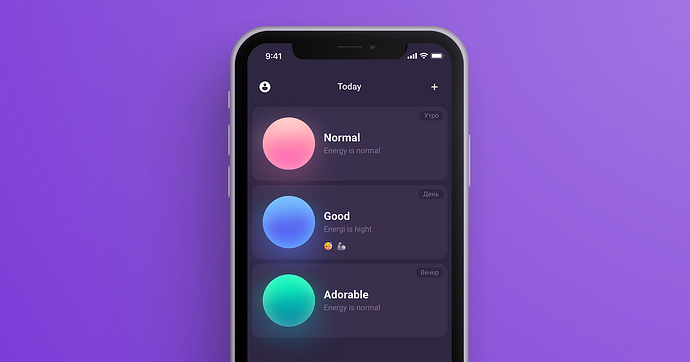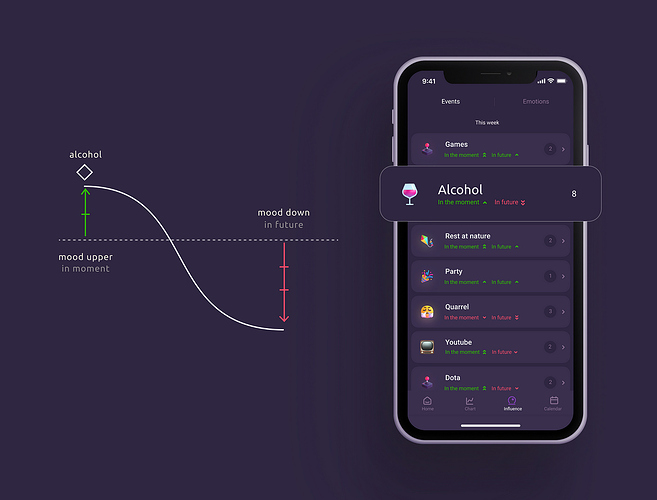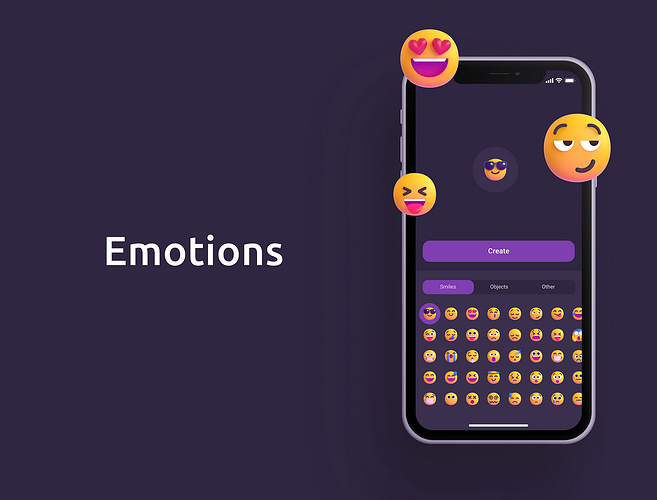Mind Tracker — application for mental health
The application shows analytics on the psychological well-being of the user.
My brother and I started making the app in the midst of COVID, when many people were facing emotional and mental problems. At that time, I was working on launching an online bank in the Philippines, which created an especially favorable environment for being out of my mind.
Before development began, I began to keep a diary of emotions in order to somehow deal with a depressive state. The process of reflection and structuring of emotions helped. I wrote down my moods, emotions, and the events that triggered them. When assessing the mood, I built a graph in Excel. It became clear that in this format it is inconvenient to do it. I went through many applications, but they did not suit me for several reasons:
- A five-point scale is used everywhere, which is not suitable for assessing mood;
- No mood analytics by time of day;
- There is no analytics of the impact of events on well-being;
- No ability to mark energy level;
- Recommendations are not customized in any way.
Then the idea came to make my own application.
Seven-point scale
First of all, we abandoned the five-point scale and started using the seven-point scale. On a five-point scale, a score of 3 is negative, whether it’s a 3 out of 5 for a movie, or a C at school. In our scale, the average mood score is the norm and does not cause negative associations.
We also decided to get away from mood visualization through emoji as much as possible. If with positive emoticons everything was not too bad, then choosing a “sad” face, when you are already in a bad mood, only infuriates. A person can experience such a strong emotion that all sad faces will look naive.
Since I am a designer, I decided to use only color coding and avoid unnecessary associations.
Times of Day
During the day, mood and general well-being change greatly. It is useful to understand what time of day is the most productive, and what time of the day is better to relax. We have added the display of analytics, including by time of day. After I started using the app I realized that I’m definitely not a night person and clearly feel better in the morning.
Energy
In the process, we realized that one scale for assessing well-being is not enough. The first test users confirmed this. Often there were situations when you were tired, but your mood was not bad, or you were angry and upset, however, more than ever full of energy. In such situations, users noted their mood as worse than it actually was, or found it difficult to assess. It was necessary to separate the mood and the amount of energy, because it is important to correctly prioritize in different states.
For example:
Good mood, but little energy — now it’s better to read a book or do any inactive tasks, it’s better not to take on 10 things at once.
A bad mood, but there is still a lot of energy left — you can go through all the old routine things that do not require much emotional involvement.
Events
Events in life directly affect our mental state.
It will not be superfluous to take into account that event provoked this or that state of health. So one of the important mechanics of the application is adding events, and the ability to see their impact on yourself. A person cannot always find a direct connection between an event and well-being. Especially in the long term.
So we made it possible to add any events, so that the application analyzes and displays their impact on the emotion graph. We take the average mood of each user, including depending on the day of the week and time of day, compare it with the median mood, and show how the event affected well-being at the moment and in the future.
The simplest examples:
- Alcohol at the moment improves mood, but in the next 24 hours the person’s mood is worse than normal.
- During sports, the mood is average, but in the next 24 hours it is much better.
There are many such connections, and they are far from always obvious, and sometimes even surprising. Who would have thought that Dota has a very bad effect on my well-being?. Almost always after the game, my mood will be worse than my usual state. And after cleaning, on the contrary, it is better, and significantly. Of course, I will not stop playing Dota, but it has become easier to take up cleaning with this knowledge.
Emotions
nitially, we wanted to visualize emotions in the form of a circle by Robert Plutchik. Plutchik believes that there are opposite emotions that cannot exist simultaneously. Now this idea is often disputed, in my own example, I realized that a person can experience opposite emotions at some points. Even just trying to choose what emotions you experience, especially if they are negative, you switch from an emotionally destructive state to a more rational one, and negative emotions become less destructive.
Notes
You can create notes in the app, and they are tied to a mood tag. Sometimes it is enough to formulate negative thoughts, and it will already become better. The plans are to make notes “smarter”, so that the application itself isolates events and emotions from the text.
Graph
We’ve done a lot of work on how to average the data. The graph should be readable at a large scale, while maintaining the top and bottom peaks. We added different weights depending on the distance from the norm.
The graph is an important tool for introspection. We all have certain cycles that run differently. The cycle can last several days or months, and the seasons also strongly affect the state. This is especially important to consider for people with bipolar disorder, borderline disorder, or cyclic depression. Find cycles, patterns on the graph and be able to “put a straw” in advance.
What else
When working with a psychologist or psychiatrist, it happens that you paint events in the color of momentary emotions, and you forget what it was like before. And if you remember, you can’t always remember the reason. The application will be able to remind. The specialist will be able to say more using your data.
There are 2 of us in the team, me and my brother. Now we do not monetize the application in any way, it is completely free, although applications with even less functionality work by subscription. We are currently working on personalized recommendations and a user profile. We are very careful in this work, because we do not want to give “bad advice”. We will always need the help of specialists from the area of psychotherapy and psychiatry. If you are the one, or if you have friends who might be interested, let us know. We are open to cooperation.
I do not want to say that now is a time when it is especially important to take care of yourself and your psyche. There is always a way to go into an apathetic or depressive state. If you have tools that support you, use them. Even formulating your experiences and writing them down on a piece of paper helps you feel better.
iOS:
Android:





